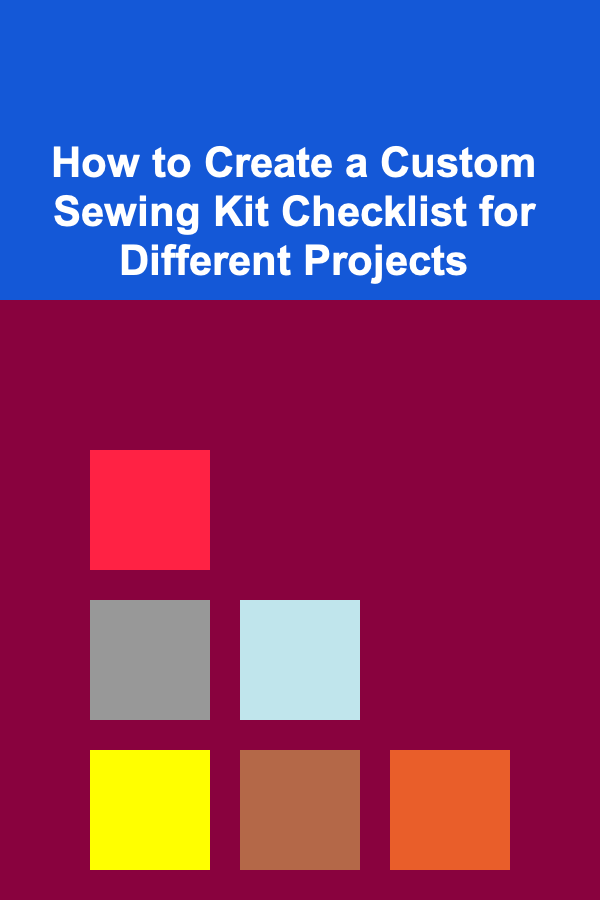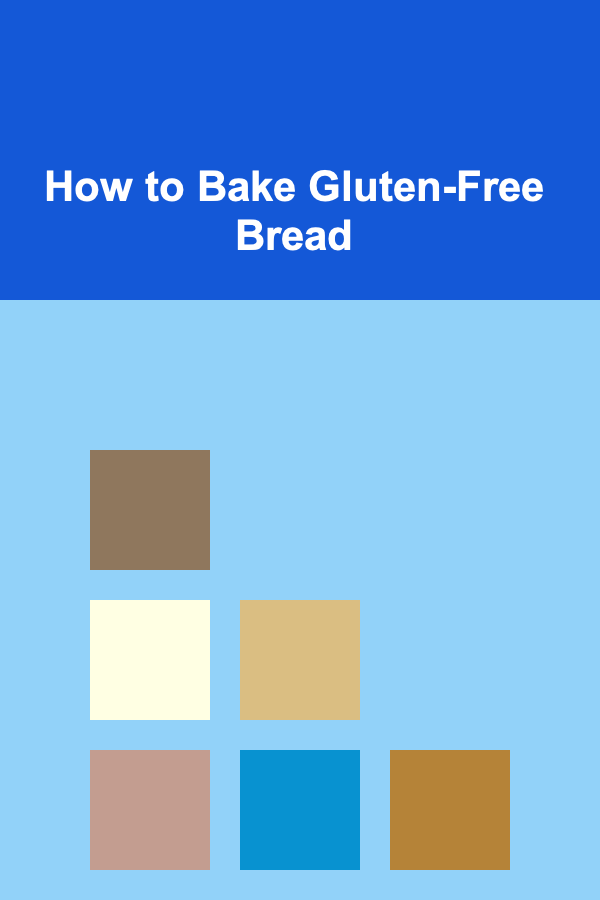
How to Create a Custom Sewing Kit Checklist for Different Projects
ebook include PDF & Audio bundle (Micro Guide)
$12.99$8.99
Limited Time Offer! Order within the next:

Sewing is a versatile and rewarding craft, whether you're a beginner just learning the basics or an experienced seamstress working on complex projects. Having the right tools on hand is crucial to your success, and that's where a well-organized sewing kit comes in. A custom sewing kit can make a world of difference when it comes to efficiency, convenience, and achieving the perfect finish on your creations.
The best part is that a sewing kit isn't a one-size-fits-all toolset; it should be customized based on the type of project you're working on. Whether you're sewing garments, quilting, or crafting home décor items, the tools you need will vary. In this article, we'll guide you through the process of creating a custom sewing kit checklist for different projects, ensuring you're always fully prepared.
Understanding the Importance of a Custom Sewing Kit
Before diving into the specifics of the checklist, it's important to understand why creating a custom sewing kit is essential. A sewing kit is much more than a bag of needles and thread. It's a curated collection of tools that ensure your projects run smoothly, saving you time and frustration.
Each sewing project has its own set of requirements. For example, when making a garment, you may need a different set of tools compared to a quilting project or home décor piece. By customizing your kit, you ensure that you have the right equipment for the job, which means you can work more efficiently and produce higher-quality results.
Basic Sewing Kit Essentials
Regardless of the type of sewing project, some tools will always be necessary. These items form the core of your sewing kit and should be available for every project. Below is a list of basic essentials that should be in every sewing kit:
1. Needles
- Hand-sewing needles: Various sizes for general hand stitching.
- Machine needles: Different sizes and types (universal, ballpoint, denim, etc.) for different fabrics.
2. Thread
- All-purpose thread: Usually polyester or cotton, suitable for most fabrics.
- Specialty threads: For specific projects (e.g., embroidery threads, heavy-duty threads for denim or leather).
3. Scissors
- Fabric scissors: Sharp, with a smooth cut for precision.
- Small snips: For trimming threads close to seams.
- Pinking shears: Used for finishing raw edges to prevent fraying.
4. Measuring Tools
- Tape measure: Flexible and essential for measuring fabric and body dimensions.
- Ruler: A long, straight edge for precise cutting and measuring.
- Seam gauge: A small, handy tool for measuring and marking seam allowances.
5. Pins and Clips
- Straight pins: For holding fabric pieces together before sewing.
- Quilting clips: These are great for thicker fabrics or when you want to avoid pin marks.
- Safety pins: Essential for temporary fastening or threading elastic through casings.
6. Marking Tools
- Chalk or fabric marking pens: For marking lines and patterns on fabric.
- Tracing paper: For transferring patterns onto fabric.
7. Iron and Ironing Board
- Iron: Essential for pressing seams, making hems, and giving your finished project a polished look.
- Ironing board: A smooth, heat-resistant surface is crucial for effective pressing.
These basic items will form the foundation of your custom sewing kit. However, depending on your specific project, you will need additional tools.
Customizing Your Sewing Kit for Different Projects
A. Garment Sewing
When it comes to garment sewing, the goal is to achieve well-fitted, durable, and comfortable clothing. Here's a custom checklist tailored for garment-making projects:
1. Sewing Machine Accessories
- Walking foot: Ideal for sewing multiple layers of fabric, such as knit or denim.
- Zipper foot: Specially designed for installing zippers.
- Buttonhole foot: For creating clean, even buttonholes.
2. Pattern Tools
- Dressmaker's tracing paper: For transferring pattern markings onto fabric.
- Pattern weights: These help hold the pattern in place without pins, ensuring accuracy and preventing distortion.
- French curve ruler: Useful for adjusting necklines, armholes, and other curved edges.
3. Notions
- Elastic: For waistbands, cuffs, and other stretchy areas.
- Buttons: Keep a variety of buttons on hand, as these are commonly used in garments.
- Bias tape: For finishing raw edges and creating neat hems.
- Hooks and eyes: For securing closures in areas like the back of dresses or skirts.
4. Fabrics and Interfacing
- Interfacing: Used for adding structure to collars, cuffs, waistbands, and more.
- Different types of fabric: Depending on your garment (e.g., cotton for shirts, denim for jeans, silk for dresses), ensure you have the right fabric on hand.
- Fusible webbing: For hems or repairs without the need for sewing.
B. Quilting
Quilting requires a specialized set of tools because of the multiple layers of fabric, batting, and backing. Here's a custom checklist for quilting projects:
1. Cutting Tools
- Rotary cutter: Perfect for cutting fabric in straight lines or curves with precision.
- Cutting mat: Essential for protecting your workspace and ensuring precise cuts.
- Rulers: A variety of quilting rulers, including a long ruler for straight lines and specialty rulers for angles.
2. Piecing and Pressing
- Quarter-inch foot: For maintaining consistent seam allowances when piecing quilt blocks together.
- Starch or spray sizing: To keep fabric crisp and prevent shifting during piecing.
- Seam ripper: Quilting involves many small, detailed seams, and mistakes happen. A seam ripper is an essential tool to fix errors.
3. Batting and Backing
- Quilt batting: Choose between cotton, polyester, or a cotton-poly blend, depending on the desired feel and thickness of the quilt.
- Quilt backing fabric: You'll need a larger amount of fabric to create the backing of the quilt, which should complement the front.
4. Quilting Notions
- Basting pins: These help secure the layers of the quilt before sewing them together.
- Quilt binding: A key component of finishing your quilt edges.
- Quilting gloves: For more control when guiding the fabric through the machine.
C. Home Décor Projects
Creating custom items for your home, such as throw pillows, curtains, and table runners, requires a mix of general sewing tools and specific items designed for heavier or more structured fabrics. Here's a checklist for home décor projects:
1. Heavy-Duty Needles
- Denim or leather needles: These are necessary for sewing through thick fabrics, such as upholstery or canvas.
2. Fabric Options
- Upholstery fabric: If you're making items like slipcovers or cushions, you'll need durable fabrics such as canvas, denim, or velvet.
- Curtain fabric: Drapery fabric is typically heavier than standard cotton and may require additional tools like drapery weights.
3. Finishing Tools
- Double-sided tape or fusible webbing: Perfect for hemming curtains or securing trims without stitching.
- Grommets or eyelets: For adding decorative elements or functional features to curtains and other home décor items.
- Fringe or trim: For enhancing pillows, cushions, or throws.
4. Heavy-duty Thread
- Polyester or nylon thread: These materials are stronger and more suitable for sewing thick home décor fabrics.
D. Crafting and Accessories Projects
For smaller items like bags, accessories, or toys, you'll need a different set of tools focused on precision, detail, and lightweight materials.
1. Small-Scale Tools
- Purse feet: Often used in handbag designs for adding feet to the bottom of bags.
- Lining fabric: For giving bags or accessories a clean finish.
- Cording: For making fabric loops, handles, or edging.
2. Adhesive Products
- Fabric glue: For temporary or decorative fixes.
- Iron-on patches or appliqué: Perfect for adding embellishments or repairing fabrics.
Organizing Your Custom Sewing Kit
An organized sewing kit makes finding the right tool for the job quick and easy. Here are some tips for keeping your kit in order:
- Use Clear Storage Bins: Transparent containers let you see your supplies at a glance.
- Label Everything: Label boxes, drawers, or bags according to the type of project or the tools inside.
- Use a Sewing Box or Caddy: A portable sewing box with multiple compartments is ideal for keeping small tools organized.
- Keep Projects Separate: If you're working on multiple projects at once, keep your tools and materials for each project in separate bags or boxes to avoid mixing them up.
Conclusion
Creating a custom sewing kit checklist is a personalized approach that can make your sewing experience more enjoyable and efficient. By understanding the specific tools required for different types of projects---whether it's garment making, quilting, home décor, or crafting---you can ensure that you're always fully prepared.
The beauty of sewing is that it offers endless possibilities, and a well-stocked, customized kit can help you tackle any project with confidence. Take the time to curate your sewing kit for the projects you most enjoy and need to work on, and you'll be on your way to creating beautiful, well-crafted items with ease.
Reading More From Our Other Websites
- [Organization Tip 101] How to Organize Your Board Games for Family Fun
- [Digital Decluttering Tip 101] Cost‑Effective Hybrid Storage: Combining On‑Premise and Cloud for Optimal Performance
- [Organization Tip 101] How to Store Your Cookbooks in Kitchen Drawers
- [Home Holiday Decoration 101] How to Set Up a Cozy Hot Chocolate Station for the Holidays
- [Tiny Home Living Tip 101] Best Ways to Incorporate Indoor Gardening in a 200‑sq‑ft Home
- [Home Space Saving 101] How to Store Office Supplies Without Taking Up Desk Space
- [Personal Care Tips 101] How to Elevate Your Personal Care Routine with Simple Mindfulness Techniques
- [Personal Care Tips 101] How to Choose the Right Eye Cream for Your Skin Type
- [Organization Tip 101] How to Keep a Time Journal for Self-Assessment
- [Organization Tip 101] How to Celebrate Achievements and Milestones in Your Workspace

How to Store Ski and Snowboard Equipment in the Off-Season
Read More
How To Paint Landscapes in Plein Air
Read More
How to Bake Gluten-Free Bread
Read More
How to Change Your Car's Air Filter: A Beginner's Guide
Read More
How to Build a Weight Loss Planner for Plant-Based Diets
Read More10 Tips for Building a Bonus Income Tracker Spreadsheet
Read MoreOther Products

How to Store Ski and Snowboard Equipment in the Off-Season
Read More
How To Paint Landscapes in Plein Air
Read More
How to Bake Gluten-Free Bread
Read More
How to Change Your Car's Air Filter: A Beginner's Guide
Read More